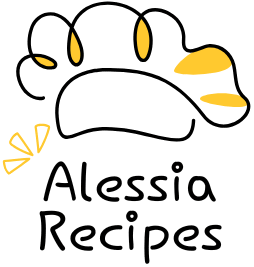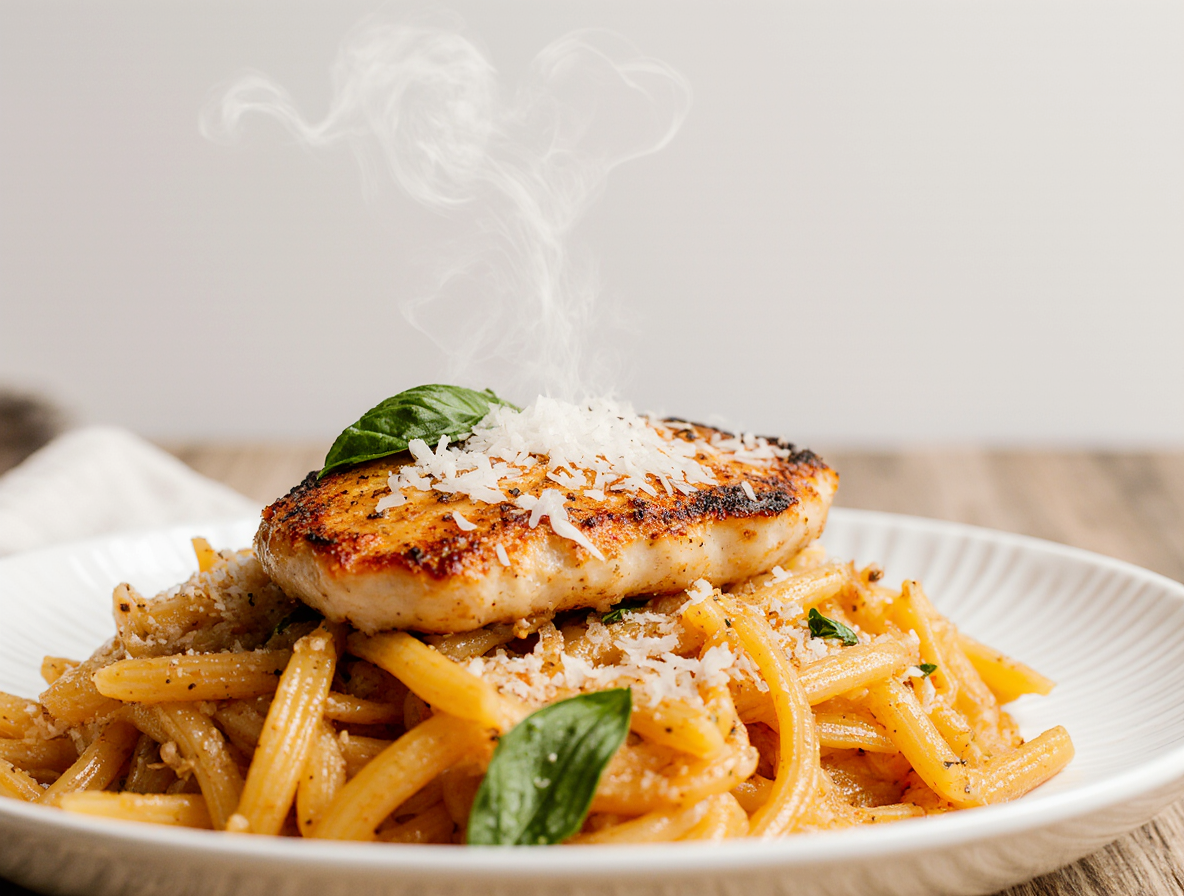How to Make Garlic Parmesan Chicken Pasta: A 30-Minute One-Pan Wonder
Garlic parmesan chicken pasta packs an impressive 107 grams of protein, 6 grams of carbs, and 8 grams of fat per serving. That’s right – this isn’t just any ordinary pasta dish!
We’re talking about a restaurant-worthy dinner that comes together in just over 30 minutes, making it perfect for busy weeknights and special occasions alike. This one pot garlic parmesan chicken pasta combines simple ingredients – chicken, pasta, garlic, and Parmesan – to create a meal the whole family will love. With its rich, decadent cream sauce and juicy chicken breast, this creamy garlic parmesan chicken pasta delivers comfort food that’s both simple and refined.
What makes this recipe truly special is how it balances nutrition with convenience. The dish is loaded with protein, carbs, and fat to keep you full, while requiring minimal pantry staples. In this article, I’ll walk you through creating this one-pan wonder step by step, from selecting ingredients to serving up a delicious meal that looks and tastes like it took hours to prepare.
Gathering Ingredients and Tools
Successful garlic parmesan chicken pasta starts with gathering the right components. Let’s break down everything you’ll need for this delicious one-pan meal.
Essential ingredients for chicken and pasta
For this creamy garlic parmesan chicken pasta, you’ll need quality proteins and aromatics. I prefer boneless skinless chicken breasts chopped into bite-sized pieces, although chicken thighs work wonderfully too and need just a couple of minutes longer to cook.
The foundation of flavor comes from:
- 3 cloves of minced garlic
- 1 small finely chopped onion
- Double cream (heavy cream in the US)
- Strong chicken stock
- Cornflour (cornstarch) for thickening
- Fresh lemon juice for brightness
- Salt, pepper, and garlic powder for seasoning
Additionally, a tablespoon of olive oil helps create that perfect sear on the chicken, consequently locking in moisture and flavor.
Choosing the right pasta and cheese
The pasta selection significantly impacts the final dish. I recommend linguine for this one-pot recipe because the sauce clings beautifully to its long strands. Nevertheless, shorter pasta shapes like penne, farfalle, or rotini work equally well.
Regarding cheese, Parmesan (Parmigiano-Reggiano) is the star of this dish. Authentic Parmesan has a distinctive nutty, savory flavor with umami richness. For the best results, choose freshly grated Parmesan rather than pre-shredded options, as the latter contains additives that prevent proper melting. Grate it using a microplane or the star side of a box grater for the finest texture.
If you’re feeling adventurous, consider Pecorino Romano as an alternative or addition. It offers a more robust, tangy flavor compared to Parmesan’s milder profile. Some chefs even combine both cheeses for a more complex flavor profile.
Recommended cookware for one-pan cooking
The magic of one-pot pasta lies in its simplicity, and proper cookware makes all the difference. I suggest using a straight-sided skillet for this recipe. This style provides enough surface area for browning chicken evenly and enough depth for cooking pasta.
Size matters tremendously—a 12- to 14-inch sauté pan works best for a pound of pasta. Too small, and your ingredients will be crowded; too large, and the sauce may reduce too quickly.
Furthermore, ensure your pan has a fitted lid to trap steam when needed. Non-stick or stainless steel pans both work well, but a quality stainless steel deep pan prevents sticking and offers excellent heat distribution.
Besides the pan, keep these tools handy:
- Wooden spoon for stirring without scratching
- Tongs for handling pasta
- Ladle for transferring cooking water to adjust sauce consistency
Prepping the Chicken and Marinade
Proper preparation sets the foundation for perfectly cooked garlic parmesan chicken pasta. Getting the chicken right makes all the difference between a mediocre meal and an extraordinary one-pot wonder.
How to cut and season the chicken
Cutting chicken correctly ensures even cooking throughout your one pot garlic parmesan chicken pasta. Firstly, pat the chicken breasts dry with paper towels to prevent slipping. For this recipe, you have several options: cut into 1-inch cubes for faster cooking, slice into strips, or butterfly the breasts for even thickness.
To butterfly, slice horizontally through the center without cutting all the way through, creating two thinner pieces that cook uniformly. Alternatively, pound the chicken to about ½-inch thickness using a meat pounder or rolling pin, then cut into portions.
For basic seasoning, a mixture of salt, pepper, and paprika creates a golden-brown exterior. Many chefs also incorporate Italian seasoning, garlic powder, and onion powder for extra depth in creamy garlic parmesan chicken pasta.
Quick marinade options for flavor
Even a 15-minute marinade can significantly improve your chicken’s flavor profile. For a simple yet effective marinade, combine:
- Olive oil (base)
- Lemon juice or vinegar (tenderizer)
- Honey or dijon mustard (flavor enhancer)
- Dried herbs like parsley or Italian seasoning
- Garlic powder and smoked paprika
For best results, place chicken in a resealable bag with the marinade, removing as much air as possible. Marinate in the refrigerator from 30 minutes up to 8 hours. Generally, avoid marinating beyond 24 hours as acidic ingredients can make chicken mushy.
Tips for tender and juicy chicken
The secret to tender chicken in your one pot garlic parmesan chicken pasta lies in technique. Cut against the grain to shorten muscle fibers, resulting in more tender bites. Moreover, avoid overcooking—chicken is done at 165°F internal temperature.
Let chicken rest for 5 minutes after cooking before slicing. This allows juices to redistribute throughout the meat instead of running out onto your cutting board.
Indeed, for meal prep convenience, you can freeze marinated chicken for up to 3 months. Simply thaw overnight in the refrigerator when ready to cook—it will continue marinating as it thaws, yielding flavorful results for your creamy garlic parmesan chicken pasta.
Cooking the Dish Step-by-Step
Now let’s dive into the actual cooking process, where all our preparation comes together in one magnificent pan.
Pan searing the chicken to perfection
The journey begins with heating oil or butter in a large skillet over medium-high heat. Place your seasoned chicken in the hot pan, allowing it to cook undisturbed for 4-5 minutes per side until golden brown. The chicken is ready when it reaches an internal temperature of 165°F. Subsequently, remove the chicken and set it aside – it will continue cooking slightly as it rests.
Making the creamy garlic parmesan sauce
In the same pan, melt butter over medium heat, then add minced garlic and cook until fragrant – typically 30-45 seconds. At this point, add white wine to deglaze the pan, scraping up those flavorful brown bits from the bottom. Shortly after, pour in heavy cream and bring to a gentle simmer. For a thicker sauce, create a roux by whisking in flour before adding the liquids.
Cooking pasta in the same pan
Pour chicken broth and just enough water to cover the pasta into the pan. Bring the liquid to a boil, afterward add your pasta and simmer according to package instructions (usually 8-12 minutes). Stir occasionally to prevent sticking.
Combining everything for final simmer
Once the pasta is nearly al dente, return the chicken to the pan. Simultaneously add grated parmesan cheese, stirring until melted. Allow everything to simmer together until the sauce thickens and coats the pasta beautifully. Garnish with fresh parsley before serving.
Tips, Variations, and Storage
This versatile dish can be customized to suit dietary needs and personal preferences. Let’s explore how to adapt and store your garlic parmesan chicken pasta.
How to make it gluten-free or dairy-free
For a gluten-free version, simply substitute regular pasta with gluten-free noodles and use gluten-free flour or cornstarch for thickening the sauce. Specifically for dairy-free adaptations, coconut milk makes an excellent substitute for heavy cream. However, note that while the sauce won’t be as thick, it will still be delicious. Alternatively, try cashew cream combined with nutritional yeast instead of parmesan for a dairy-free cheese flavor.
Add-ins like spinach, mushrooms, or bacon
Fresh spinach adds color, nutrition, and balances the richness of the creamy sauce. Notably, you can incorporate vegetables like onions, shallots, bell peppers, or brussels sprouts by cooking them alongside the chicken. For mushroom lovers, shiitake varieties bring exceptional flavor. As well as these options, consider sun-dried tomatoes for Mediterranean flair or a splash of white wine for depth. Bacon or chorizo can be added for extra protein and smoky flavor.
Storing and reheating leftovers
Store leftovers in an airtight container in the refrigerator for 3-5 days. Fortunately, reheating is straightforward – on the stovetop, heat over low-medium temperature with a splash of milk or broth to restore creaminess. In fact, for microwave reheating, use medium power in 30-second increments, stirring between sessions. Freezing is possible for up to 3 months, yet be aware the sauce texture might change slightly upon thawing.
Common mistakes to avoid
Patting chicken dry before seasoning ensures a golden sear rather than steaming it. Essentially, reserving pasta water is crucial as it helps loosen the sauce and helps it cling to noodles. Another common error is overcooked pasta – always test it a minute before the package suggests. Furthermore, never rinse pasta after cooking (except for cold pasta salads) as this removes the starch that helps sauce adhere.
Conclusion
Garlic parmesan chicken pasta truly stands out as an ideal weeknight dinner solution. Throughout this guide, we’ve explored how simple ingredients transform into a protein-packed, flavor-rich meal that satisfies both nutrition needs and taste buds. Additionally, the one-pan approach minimizes cleanup while maximizing flavor development.
Most importantly, this recipe offers remarkable flexibility. You can easily adapt it for gluten-free or dairy-free diets, add vegetables like spinach or mushrooms, or incorporate bacon for extra richness. All these modifications still maintain the core appeal of the dish – that perfect balance of creamy sauce, tender chicken, and al dente pasta.
The techniques shared here extend beyond this specific recipe. Learning to properly cut chicken, create a quick marinade, and build a creamy sauce will serve you well across countless other dishes. Therefore, mastering this garlic parmesan chicken pasta opens doors to many cooking possibilities.
Remember that proper storage allows you to enjoy leftovers for days afterward. Though nothing beats the fresh version straight from the pan, a properly reheated portion makes an excellent lunch option the next day.
Next time you need a satisfying meal that comes together quickly without sacrificing flavor or nutrition, this garlic parmesan chicken pasta deserves a spot at your table. After all, few dishes deliver this much satisfaction with so little effort and time investment.
FAQs
Q1. What type of pasta works best for garlic parmesan chicken pasta? While linguine is recommended for its ability to hold the sauce well, you can also use shorter pasta shapes like penne, farfalle, or rotini. The key is to choose a pasta that can grip the creamy sauce effectively.
Q2. How do you make the creamy garlic parmesan sauce? The sauce is made by melting butter, sautéing garlic, deglazing with white wine, and then adding heavy cream. Parmesan cheese is stirred in towards the end to create a rich, creamy consistency.
Q3. What are the main ingredients for parmesan chicken pasta? The core ingredients include chicken breasts, pasta, garlic, Parmesan cheese, and heavy cream. Additional components like chicken stock, onions, and seasonings enhance the flavor profile.
Q4. Should the chicken or pasta be cooked first? It’s best to start by cooking the chicken first. While the chicken is cooking, you can begin boiling the pasta water. This timing allows both components to finish around the same time for combining in the final dish.
Q5. How can I make this dish gluten-free or dairy-free? For a gluten-free version, use gluten-free pasta and cornstarch for thickening. To make it dairy-free, substitute heavy cream with coconut milk and use nutritional yeast instead of Parmesan cheese for a cheesy flavor.


